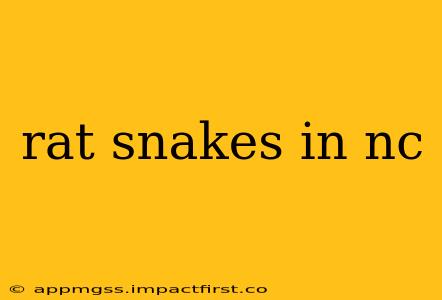North Carolina is home to several species of rat snakes, non-venomous constrictors known for their size, agility, and important role in the ecosystem. Understanding these snakes, their behaviors, and their habitats is crucial for peaceful coexistence and appreciating the biodiversity of the state. This comprehensive guide will delve into the world of NC rat snakes, addressing common questions and concerns.
What Kinds of Rat Snakes Live in North Carolina?
North Carolina boasts a diverse population of rat snakes, primarily including the Eastern Ratsnake ( Pantherophis alleghaniensis), the Black Ratsnake (Pantherophis obsoletus), and occasionally the Corn Snake (Pantherophis guttatus), though the latter is less common in the wild within the state. These snakes can vary significantly in color and pattern, leading to occasional misidentification. The Eastern Ratsnake is often mistaken for a Copperhead due to its coloration, highlighting the importance of accurate identification. Identifying features such as the shape of the head (rat snakes have smooth, oval heads, unlike the triangular head of a venomous snake) and the presence or absence of heat-sensing pits (absent in rat snakes) are critical for differentiation.
Are Rat Snakes Dangerous?
No, rat snakes are not venomous. They are constrictors, meaning they kill their prey by squeezing it until it suffocates. While they can deliver a painful bite if they feel threatened, this is purely defensive and rarely causes serious injury. Their bite is analogous to a dog's nip; unpleasant but not venomous. They pose no significant threat to humans, and the best course of action upon encountering one is to leave it alone.
How Big Do Rat Snakes Get in NC?
Rat snakes in NC can grow to impressive sizes. Eastern Ratsnakes typically reach lengths of 4-6 feet, while Black Ratsnakes can be even larger, sometimes exceeding 7 feet. Their size contributes to their effectiveness as predators, allowing them to subdue larger prey.
What Do Rat Snakes Eat?
Rat snakes are excellent hunters, as their name suggests, and their diet primarily consists of rodents. Their prey also includes birds, eggs, lizards, frogs, and other small animals. Their hunting abilities are a valuable asset to the ecosystem, contributing to rodent control and maintaining ecological balance.
Where Do Rat Snakes Live in NC?
Rat snakes are adaptable creatures found in a variety of habitats across North Carolina. You can find them in forests, fields, marshes, and even near human settlements. They are often found near sources of water and shelter, such as rock piles, hollow logs, and abandoned burrows. Their ability to thrive in diverse environments explains their widespread distribution throughout the state.
What Should I Do If I See a Rat Snake in My Yard?
The best course of action upon encountering a rat snake is to observe it from a safe distance and allow it to move on its own. They are generally not aggressive and will avoid confrontation whenever possible. If you are uncomfortable with its presence near your home, gently guide it away using a broom or a long stick. Avoid attempting to handle or capture it, and never strike or harm the snake.
How Can I Prevent Rat Snakes From Entering My Home?
Preventing rat snakes from entering your home involves eliminating potential entry points. Seal any cracks or gaps in your foundation, around pipes, and in window frames. Keep your yard clean and free of debris that could provide shelter, and store firewood away from your house. Regularly inspect your attic and basement for any signs of snake entry.
Are Rat Snakes Protected in North Carolina?
While not explicitly listed as protected species, rat snakes, like many other non-venomous snakes, are an important part of North Carolina's wildlife and are afforded protection under general wildlife laws. It's illegal to intentionally harm or kill them without a valid permit.
By understanding rat snakes and their behavior, North Carolinians can foster a respectful coexistence with these valuable members of the state’s diverse ecosystem. Remember, appreciating their role in controlling rodent populations is vital, promoting a healthier environment for both wildlife and humans.
